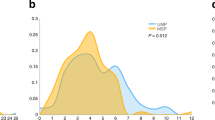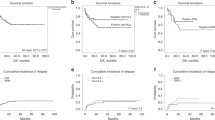Summary:
In major histocompatibility complex (MHC)-matched allogeneic hematopoietic stem cell transplantation (HSCT), donor responses are directed against multiple host minor histocompatibility antigens (mHAgs), producing graft-versus-host disease (GVHD) and graft-versus-tumor (GVT) effects. We studied MHC-matched, mHAg-mismatched C3H.SW>C57BL/6 HSCT in which three mHAg are molecularly defined (B6dom1, H3, H13) to determine if there is a hierarchy of immunodominance among the mHAgs and to learn the contribution of each to GVHD. We found that B6dom1 was the immunodominant mHAg. B6dom1 did not block responses to the subdominant mHAgs H3 and H13. The mechanism of immunodominance was not mHAg avidity or affinity for class I. B6dom1 elicited a broader variety of Vβ clonotypes than either H3 or H13. Severe GVHD could occur in the absence of a strong B6dom1 response. Alloreactivity to isolated B6dom1, H3 or H13 differences did not produce severe GVHD. We concluded that immunodominance is explained by both mHAg density on host cells and the repertoire of donor T cells capable of responding to the mHAgs. Clinically significant GVHD requires donor responses to multiple mHAgs. Modulation of responses to a single immunodominant mHAg is insufficient for the prevention of GVHD, while immunotherapies directed against isolated mHAgs may not provoke severe GVHD.
This is a preview of subscription content, access via your institution
Access options
Subscribe to this journal
Receive 12 print issues and online access
$259.00 per year
only $21.58 per issue
Buy this article
- Purchase on Springer Link
- Instant access to full article PDF
Prices may be subject to local taxes which are calculated during checkout









Similar content being viewed by others
References
Green MC, Witham BA . Handbook on Genetically Standardized Jax Mice. 4th edn. Jackson Laboratory: Bar Harbor, ME, 1991.
Korngold R, Sprent J . Variable capacity of L3T4+ T cells to cause lethal graft-versus-host disease across minor histocompatibility barriers in mice. J Exp Med 1987; 165: 1552–1564.
Eden PA, Christianson GJ, Fontaine P et al. Biochemical and immunogenetic analysis of an immunodominant peptide (B6dom1) encoded by the classical H7 minor histocompatibility locus. J. Immunol. 1999; 162: 4502–4510.
Zuberi AR, Christianson GJ, Mendoza LM et al. Positional cloning and molecular characterization of an immunodominant cytotoxic determinant of the mouse H3 minor histocompatibility complex. Immunity 1998; 9: 687–698.
Mendoza LM, Paz P, Zuberi A et al. Minors held by majors: the H13 minor histocompatibility locus defined as a peptide/MHC class I complex. Immunity 1997; 7: 461–472.
Chen W, Anton LC, Bennink JR, Yewdell JW . Dissecting the multifactorial causes of immunodominance in class I-restricted T cell responses to viruses. Immunity 2000; 12: 83–93.
Pion S, Fontaine P, Desaulniers M et al. On the mechanisms of immunodominance in cytotoxic T lymphocyte responses to minor histocompatibility antigens. Eur J Immunol 1997; 27: 421–430.
Pion S, Christianson GJ, Fontaine P et al. Shaping the repertoire of cytotoxic T-lymphocyte responses: explanation for the immunodominance effect whereby cytotoxic T lymphocytes specific for immunodominant antigens prevent recognition of nondominant antigens. Blood 1999; 93: 952–962.
Anderson LD, Savary CA, Mullen CA . Immunization of allogeneic bone marrow transplant recipients with tumor cell vaccines enhances graft-versus-tumor activity without exacerbating graft-versus-host disease. Blood 2000; 95: 2426–2433.
Anderson LJ, Petropoulos D, Everse LA, Mullen CA . Enhancement of graft-versus-tumor activity and graft-versus-host disease by pretransplant immunization of allogeneic bone marrow donors with a recipient-derived tumor cell vaccine. Cancer Res 1999; 59: 1525–1530.
Fontaine P, Roy-Proulx G, Knafo L et al. Adoptive transfer of minor histocompatibility antigen-specific T lymphocytes eradicates leukemia cells without causing graft-versus-host disease. Nat Med 2001; 7: 789–794.
Wei ML, Cresswell P . HLA-A2 molecules in an antigen-processing mutant cell contain signal sequence-derived peptides. Nature 1992; 356: 443–446.
Restifo NP, Esquivel F, Asher AL et al. Defective presentation of endogenous antigens by a murine sarcoma: implications for the failure of an anti-tumor immune response. J Immunol 1991; 147: 1453–1459.
Townsend A, Bodmer H . Antigen recognition by class I-restricted T lymphocytes. Ann Rev Immunol 1989; 7: 601–624.
Greenfield A, Scott D, Pennisi D et al. An H-YDb epitope is encoded by a novel mouse Y chromosome gene. Nat Genet 1996; 14: 474–478.
Everse LA, Anderson LD, Rooijen N, Mullen CA . Bone marrow transplant conditioning intensified with liposomal clodronate to eliminate residual host antigen presenting cells fails to ameliorate GVHD and increases peri-BMT mortality. Transplantation 2001; 71: 611–618.
Sercarz EE, Lehmann PV, Ametani A et al. Dominance and crypticity of T cell antigenic determinants. Annu Rev Immunol 1993; 11: 729–766.
Yewdell JW, Bennink JR . Immunodominance in major histocompatibility complex class I-restricted T lymphocyte responses. Annu Rev Immunol 1999; 17: 51–88.
Bastin J, Rothbard J, Davey J et al. Use of synthetic peptides of influenza nucleoprotein to define epitopes recognized by class I-restricted cytotoxic T lymphocytes. J Exp Med 1987; 165: 1508–1523.
Townsend AR, Gotch FM, Davey J . Cytotoxic T cells recognize fragments of the influenza nucleoprotein. Cell 1985; 42: 457–467.
Villanueva MS, Sijts AJ, Pamer EG . Listeriolysin is processed efficiently into an MHC class I-associated epitope in Listeria monocytogenes-infected cells. J Immunol 1995; 155: 5227–5233.
Choi EY, Yoshimura Y, Christianson GJ et al. Quantitative analysis of the immune response to mouse non-MHC transplantation antigens in vivo: the H60 histocompatibility antigen dominates over all others. J Immunol 2001; 166: 4370–4379.
Dey B, Yang Y-G, Preffer F et al. The fate of donor T-cell receptor transgenic T cells with known host antigen specificity in a graft-versus-host disease model. Transplantation 1999; 68: 141–149.
Walter EA, Greenberg PD, Gilbert MJ et al. Reconstitution of cellular immunity against cytomegalovirus in recipients of allogeneic bone marrow by transfer of T-cell clones from the donor. N Engl J Med 1995; 333: 1038–1044.
Scott D, Addey C, Ellis P et al. Dendritic cells permit identification of genes encoding MHC class II-restricted epitopes of transplantation antigens. Immunity 2000; 12: 711–720.
Acknowledgements
This work was supported in part by a Research Scholar Grant (RSG-98-035-04-LIB) from the American Cancer Society (CAM), a grant from the Texas Higher Education Coordinating Board Advanced Technology Program (No. 003657-0101-1999)(CAM), and by grant support from the National Institutes of Health (5T32CA073954-05) (SM). Support for the Peptide Core Lab and Veterinary Services was provided by NIH Cancer Center Core Grant CA16672.
Author information
Authors and Affiliations
Rights and permissions
About this article
Cite this article
Mori, S., El-Baki, H. & Mullen, C. Analysis of immunodominance among minor histocompatibility antigens in allogeneic hematopoietic stem cell transplantation. Bone Marrow Transplant 31, 865–875 (2003). https://doi.org/10.1038/sj.bmt.1704021
Received:
Accepted:
Published:
Issue Date:
DOI: https://doi.org/10.1038/sj.bmt.1704021
Keywords
This article is cited by
-
Estimating design space available for polyepitopes through consideration of major histocompatibility complex binding motifs
Biomedical Microdevices (2010)
-
Differential gene expression in acute lymphoblastic leukemia cells surviving allogeneic transplant
Cancer Immunology, Immunotherapy (2010)



